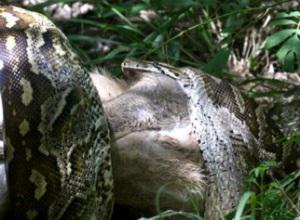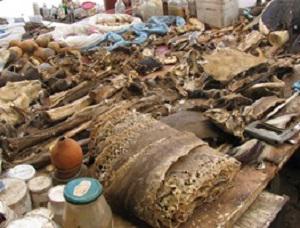Bryan Maritz
Other projects
To better understand functional biodiversity of terrestrial vertebrates and how human utilisation of these my impact ecosystem functioning and resilience.

A Southern African Python (Python natalensis) constricts and swallows a Common Duiker (Sylvicapra grimmia) at the study site in Mpumalanga, South Africa. Both species perform important functional roles in the ecosystem. Photo by B Maritz.
Increasing resource demands by burgeoning human populations is pushing ecosystems to, and over, the brink of collapse. In rural communities, there is tight link between human livelihoods and ecosystem good and services that result from ecosystem processes. This link demands informed natural resource utilisation to ensure sustainability. Understanding ecosystem resilience (the amount of disturbance an ecosystem can tolerate before changing) can help to identify species that are critical to ecosystem processes, the maintenance of biodiversity, and the production of ecosystem goods and services.

A traditional medicine market in Johannesburg, South Africa showing a wide variety of animal products for sale, including the skin of a large southern African Python (Python natalensis).
Increased ecosystem resilience results from the presence of numerous species performing similar functions (i.e., occupying the same functional group), such that the loss of one or few species from the ecosystem does not result in the disappearance of that ecological process. If however the species that are being over-exploited tend to perform similar ecological functions, or occupy species-poor functional groups then continued harvesting pressure could result in fundamental losses of biodiversity and the production of EG&S on which people rely. Thus, knowledge regarding which species people use, and the functional groups to which they belong, is essential to conserving biodiversity. Despite its importance however, such information is available for few ecosystems, especially in developing nations like South Africa.
This study aims to identify functional groups of species that occur within the ecosystem, and quantify the effects of wildlife exploitation on ecosystem function such that we can manage vulnerable animal populations.
This project involves intensive biodiversity surveying as a core component. Once the entire terrestrial vertebrate (all species of amphibians, reptiles, mammals and birds) have been surveyed across multiple sites in the study area, I will quantify various functional traits of those species, along with ethno-zoological information regarding which species are utilised by people in the region. In this context I will be able to identify groups of species that perform important ecosystem functions, and that may be at risk of over-exploitation. In doing so I aim to provide a framework that facilitates the development of a sustainable resource management strategy, and highlights targets for social programs designed to alleviate ecosystem pressure.